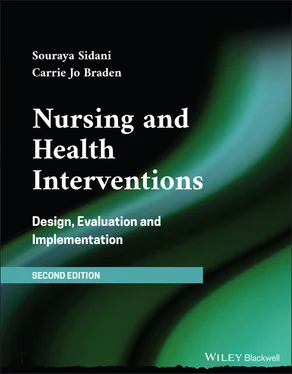3.2.1 Definition of the Health Problem
The theory identifies the health problem (i.e. what it is called such as insomnia), defines it at the conceptual and operational levels. The conceptual definition describes the nature of the problem, whereas the operational definition delimits its attributes.
3.2.1.1 Conceptual Definition
The nature of the health problem characterizes what it is about. It is described in terms of its categorization as actual or potential, and by the domain of health in which it is experienced.
Categorization of Health Problems
An actual problem is an existing situation with which clients present that requires intervention. It reflects an alteration in health, or a dysfunction, and/or an undesirable behavior that clients actually experience or exhibit, respectively at a particular point in time. Examples of actual health problems include symptoms such as pain and fatigue; difficulty performing activities of daily living; less‐than‐optimal adherence to treatment recommendations; an epidemic or spread of infectious disease in the community; and caregiving burden.
A potential problem refers to a discrepancy between a current situation (i.e. the way things are) and an ideal situation (i.e. the way things ought to be). It reflects an inadequacy in the type or level of current functioning, and/or an inadequacy in the type or level of healthcare services, that increases the probability of resulting in an actual problem. Potential problems are illustrated by: engagement in undesirable health behaviors such as smoking that increases the risk of lung cancer; the need for information, support, or additional services to promote engagement in physical activity; or shortage in the number of nurse practitioners with expertise in geriatrics care to provide comprehensive care to the growing aging population and prevent admission to acute care hospitals.
The categorization of health problems determines the overall goal of the intervention and the timing within the trajectory of the health problem experience for its delivery. For actual health problems, interventions are designed to manage them, that is, to improve the problems' experience, treat or resolve them, or assist clients to manage them successfully. The interventions are provided after the occurrence of the actual problem. For potential health problems, interventions are geared to prevent them, that is, reduce the chances of their occurrence. The interventions are offered before the occurrence of the problems.
Domains of Health Problems
The nature of the health problem also reflects the domain of health in which it is experienced. Actual or potential problems exhibit as alterations in any or combination of health domains: biological (e.g. bone fracture, muscle injury); physiological (e.g. high blood pressure or glucose levels); physical (e.g. difficulty walking); cognitive (e.g. difficulty remembering things); psychological/emotional (e.g. stress); behavioral (e.g. substance abuse); social (e.g. lack of social support network); cultural (e.g. proscribed practices); and spiritual (e.g. lost meaning in life).
The conceptualization of the problem as experienced in a particular or combination of health domains informs the general strategy underlying the intervention. The strategy should be consistent with the nature of the problem. For instance, conceptualizing insomnia as a cognitive problem (e.g. Harvey et al., 2017), or a behavioral problem (e.g. Bootzin & Epstein, 2011), or a combined cognitive and behavioral problem (e.g. Schwartz & Carney, 2012) suggests the need for a cognitive, behavioral, or cognitive‐behavioral approach, respectively, for its management. Interventions focusing only on education are not consistent with these conceptualizations of insomnia and, therefore, are likely to be ineffective in resolving this health problem.
3.2.1.2 Operational Definition
The attributes of the health problem are the indicators of its presence and distinguish it from other problems. The attributes are described in terms of the type and level of indicators that define the problem, as well as the severity and duration with which the problem is experienced.
Type and Level of Indicators
Indicators reflect how the problem is manifested. They are the particular alterations or changes in structure or function that point to the presence of the problem. The indicators may be objectively observed (i.e. signs) or subjectively reported (i.e. symptoms). For example, difficulty initiating sleep (i.e. falling asleep) and maintaining sleep (i.e. staying asleep) are two indicators of insomnia. It is important to note that the experience of the indicators may vary within and across client populations. The variation may be associated with different client characteristics such as age, gender, and culture. For example, the indicators of insomnia vary with age: Middle‐aged persons frequently report experiencing difficulty falling asleep, whereas older persons frequently report difficulty staying asleep (Sidani et al., 2018a).
The identification of the indicators can be supplemented by the specification of the level at which they are experienced in order to operationally define the health problem. Level of experiencing the indicators is reflected in a range of values or cutoff scores that should be observed or reported to indicate the presence of the problem. For example, difficulty falling asleep and/or staying asleep may be experienced by anyone, under a wide range of circumstances (e.g. clients may not sleep well a few days before surgery). To indicate the presence of insomnia, these sleep difficulties or disturbances should occur for 30 minutes or more per night, over at least three nights per week.
Severity and Duration of the Health Problem
Severity refers to the intensity with which the health problem is experienced. It has to do with “how badly,” serious and/or distressing the problem is. The level of severity can be objectively assessed (e.g. level of dependence in performance of activities of daily living, or number of cigarettes smoked) or subjectively rated for its distress or burden by clients, using relevant measures and rating scales. For example, the Insomnia Severity Index assesses clients' perception of how distressing their sleep problem is, and how much it interferes with daytime functioning; the total score quantifies the level of insomnia severity (Morin et al., 2011).
Duration refers to the time period over which the health problem is experienced. It determines the acuity or chronicity of the problem, which may be associated with different sets of contributing factors. For example, the experience of the sleep difficulties as described previously, over at least three months, indicates the presence of chronic insomnia, which is primarily associated with sleep‐related behaviors; acute insomnia is experienced as a result of life events.
Generating a list of indicators, describing each indicator accurately, and specifying the severity and duration of the health problem's experience are important. A critical analysis of the indicators points to those that are amenable to change and for which interventions or components of an intervention can be designed to directly address them and, hence, contribute to the management or resolution of the problem. For example, dyspnea is manifested by rapid short breathing, suggesting that clients can be instructed to perform deep breathing exercises to control this specific indicator of dyspnea. The severity and duration of the health problem's experience inform the identification of factors that contribute to the problem.
3.2.1.3 Factors Contributing to the Problem
Читать дальше












